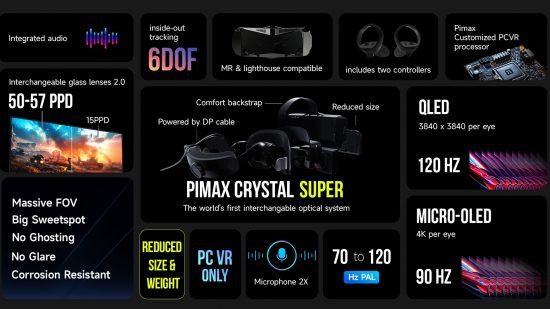Pimax is going all in on a new high-end premium VR headset, the Crystal Super. It features the world’s first changeable optical engine for both QLED and Micro-OLED. In simple terms, you’ll be seeing far more, and in greater detail, compared to the already class-leading Pimax Crystal.
Speaking of the Pimax Crystal, it features on our list of the best VR headsets for its incredible display and visual fidelity, but the Crystal Super is about to blow it out of the water. Based on numbers alone, the Crystal Super will increase the total pixel count from 16.6 million to 29.6 million.

Rather than making you choose between QLED or Micro-OLED, Pimax found a way to make the display engines interchangeable, resulting in a modular design that allows you to change panel types like you would the battery on the base Crystal headset.
The Micro-OLED display uses pancake lenses with a max refresh rate of 90Hz and 4K resolution while the QLED sticks to glass aspheric lenses but can go up to 120Hz, with a massive resolution of 3840p.
The Pimax Crystal Super also ditches the standalone mode, something that we were left unimpressed with during our time with the Crystal, and this allows Pimax to focus entirely on PCVR. Furthermore, the lighter feel of the headset will also create a more comfortable experience that will allow for longer sessions and rescue the risk of a repetitive strain injury.
The promise of a massive FOV, no ghosting or glaring, and a big visual sweet spot is going to be hard to live up to, but Pimax is never conservative with its technological goals, and if it pulls this off, it can only be good for VR as a hobby.
It has to be noted, however, that this headset is not intended for casual VR gamers. Largely down to the price, which I’ll touch on momentarily, but also because you will need a substantially powerful gaming PC to get the most out of the Pimax Crystal Super. The original Crystal ideally needs at least an Nvidia RTX 3080, although the minimum requirement is an RTX 2070.
If you want to purchase the Pimax Crystal Super with both display engines included, it will cost $2,399. The QLED model alone will cost $1,799 whereas the micro-OLED model will cost $1,999. Shipping is expected to begin in Q4 2024.

Also announced during the showcase was the Pimax Crystal Airlink, a wireless adaptor that allows the base Pimax Crystal headset to be used wirelessly, utilizing its heavy-duty battery and ditching the tether needed for PCVR play. This will cost $299 and has an unspecified 2024 shipping date.
If this announcement has you itching to get started with VR, check out our Meta Quest 3 review, and also the best VR games you can play on PC right now.